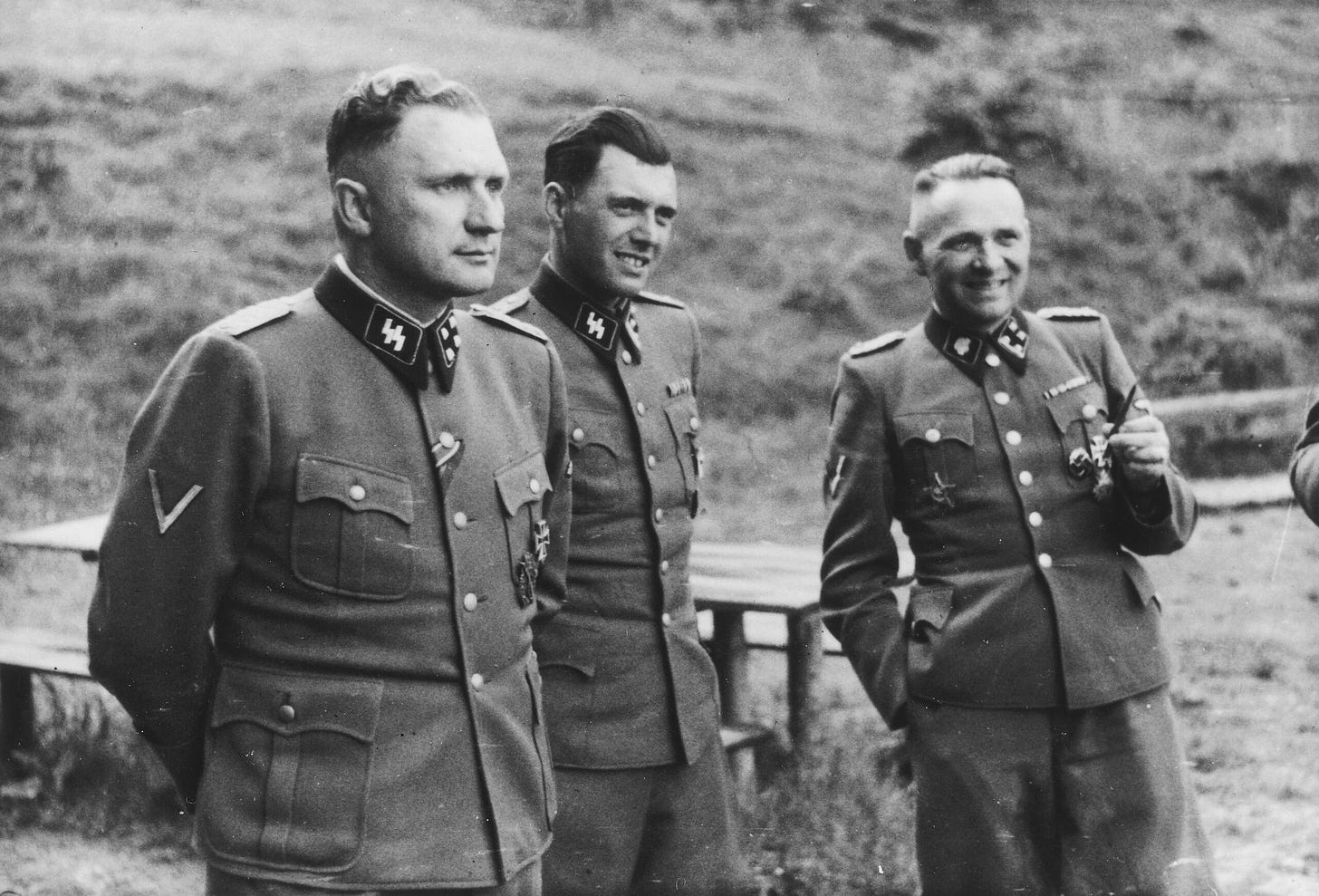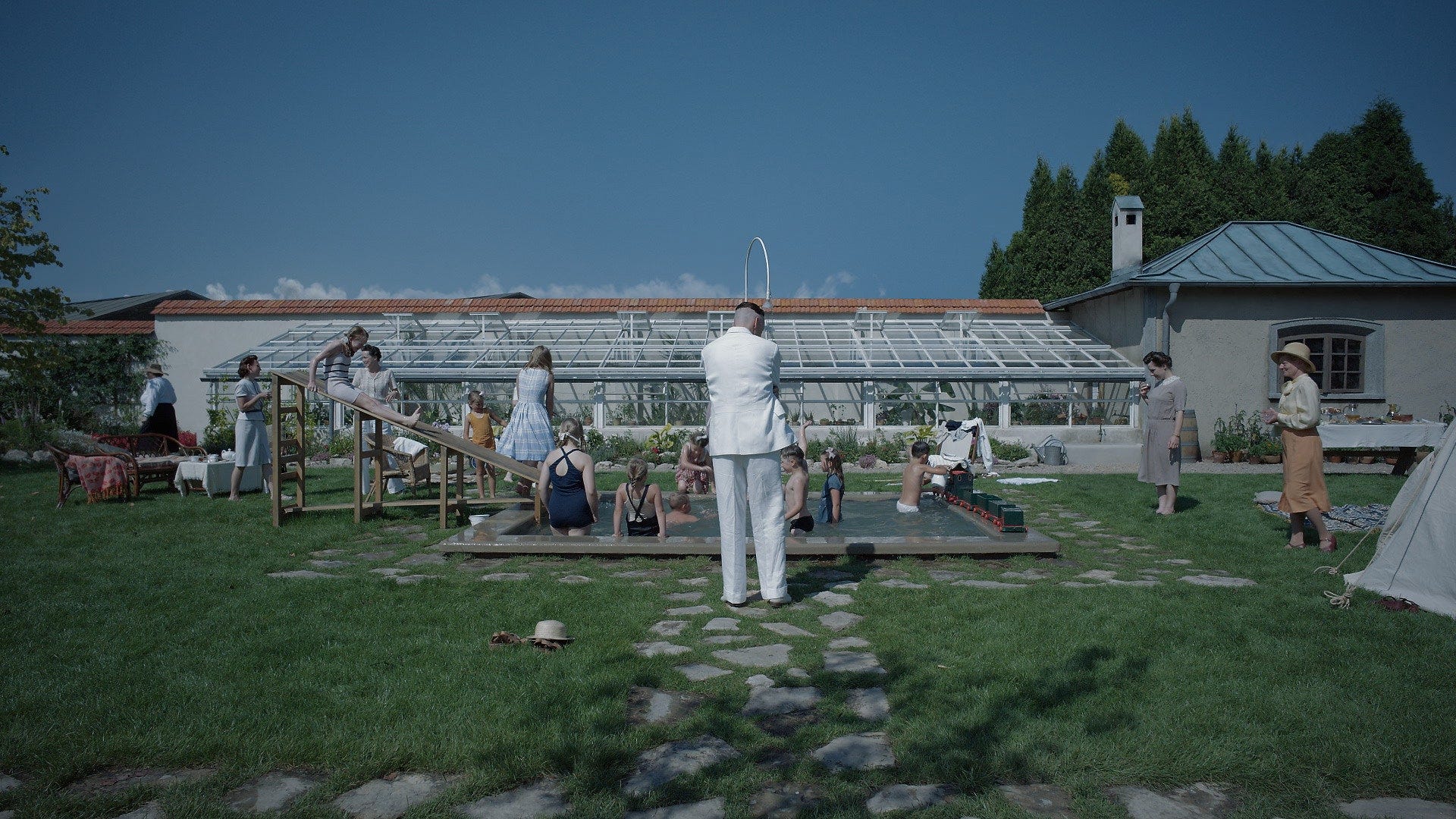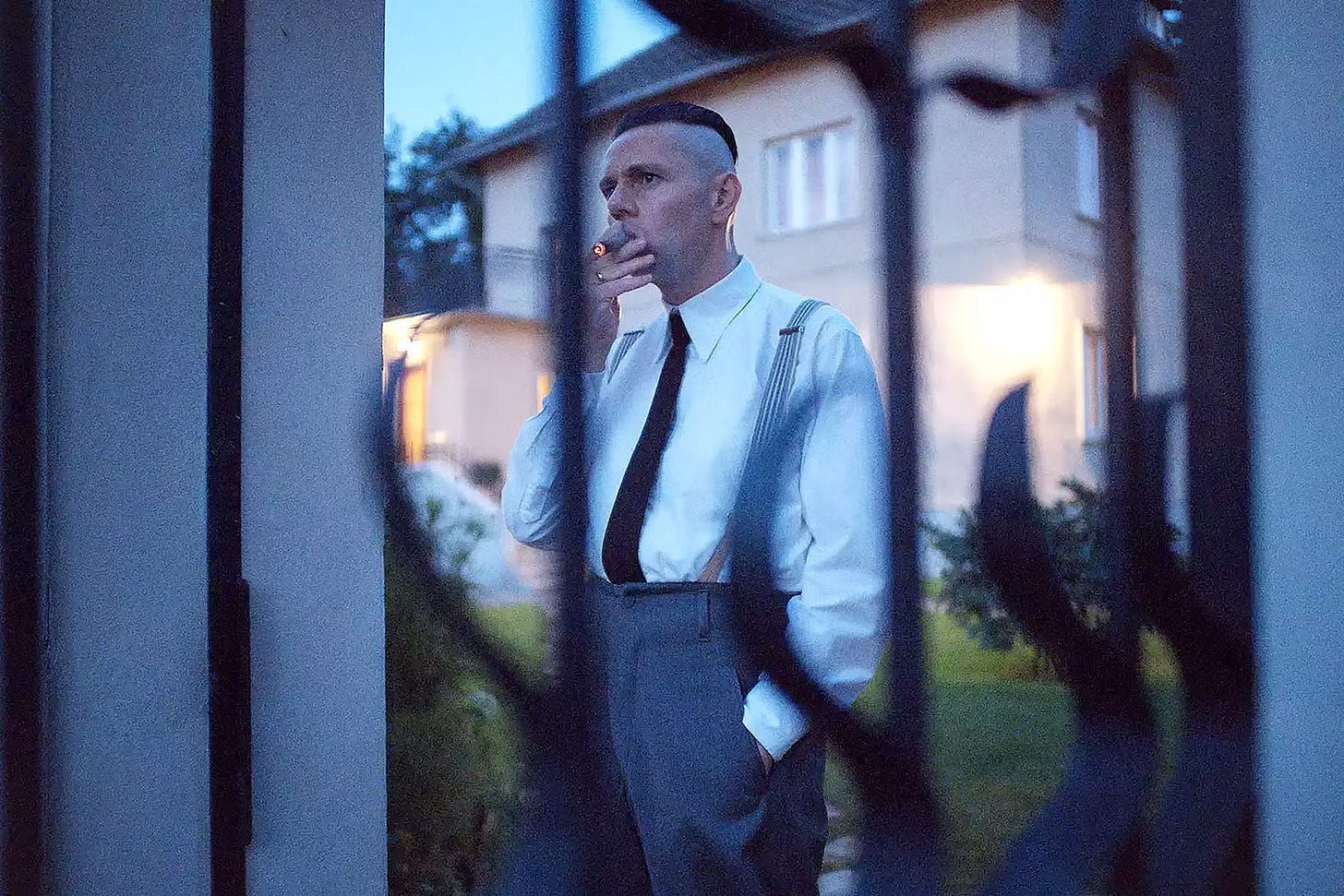When I read about Jonathan Glazer’s The Zone of Interest (2023), I intuitively understood that this motion picture would be more horrific than any previous film on the Holocaust had ever approximated. For what could be more hideous than following this genocide from the perspective of the everyday lives of its perpetrators whose lives lend a facade of normality, while adjacent to their domestic spaces and quotidian rituals, is the off-screen horrific violence contained within Auschwitz?
The Zone of Interest exposes the daily lives of Rudolf Höss, an SS officer and commandant of the Auschwitz concentration camp from May 1940 to November 1943, and his wife Hedwig. The genius of this film is that the horrors of the concentration camp are never shown, but are only heard and intimated through the juxtaposition of certain images and sounds, ultimately allowing the spectator to feel the horror of the Holocaust in ways that direct representation and shock images fail.
Glazer’s film is a full-on critique of Holocaust exceptionalism and its timing couldn’t be more fitting than to have been released just months after Israel began its genocide of Palestinians in Gaza. The Zone of Interest reveals how the normalisation of violence within the context of Auschwitz was achieved through techniques that sadly are still in use by political forces today: where posh housing, beautiful gardens, work promotions, status, profits and the wellbeing of individuals are placed in direct opposition—even competition—with poverty, violence, and various other forms of oppression, most notably class. Even the Polish servants who work for the Höss family are voiceless and powerless and because of their low social status, they too become symbols of possession and the means of enabling the greater systems of oppression. Having been given the tour of the villa, replete with these servants, Hedwig’s mother, Linna (Imogen Kogge), tells her daughter, “You’ve certainly landed on your feet, my girl.”
We are spectators to the mundane movements and dialogues of the Höss family that easily parallel the horrors of numerous other historical atrocities without making this particular genocide exceptional. Glazer shows the viewer how they are inextricably part of the narrative, unable to withdraw from their implied role of interpreter within the film since the denial of the genocide as represented by the wall is already transgressed by us: we are aware of what is happening on the other side of the wall due to our historical knowledge of the Holocaust. The wall as metaphor retains its strength in the present tense as this film examines the denialism that this wall symbolises for those agents of the Holocaust like the Höss family and this film exposes the walls for those of us living today where denial of any number of myriad atrocities across the planet today is commonplace. Today we live in a state of constantly-televised barbarousness which lends to our incessant proximity to human atrocity. Walls today are psychological structures of denialism as citizens of conflicts perfectly rationalise the violence committed in their name as they choose to remain blind to the violence, even renaming the violence as “necessary.” If anything, Glazer has completed the awesome task of showing how a society—perpetrators and bystanders alike—create mental walls to avoid seeing what is right there before them.

Throughout The Zone of Interest we only see what occurs within and around the “normal,” quotidian happenings of the Höss villa. All the barbarousness within this film takes place behind the garden wall that separates the serene and beautiful setting of this family’s domestic life from the other side of the garden wall: Auschwitz. Instead of centring violence within the film’s plot as per Schindler’s List among numerous films of that genre, the depravity of what occurred in Auschwitz is subtly embodied through the absence of direct visual representation. All violence within the film is invisible to the eye and instead the complex soundtrack of horror serves as the film’s centre for understanding the savageness that is taking place over the wall. The soundtrack operates in synchronicity with certain images and non sequiturs that are often not coherent within a linear narrative, but which later make sense. Normal life events are interwoven with executions of violence that are either heard over the wall—gunshots, shouts, screams, and the industrial sounds that punctuate the film’s soundtrack—or shown through images of smoke, children being whisked out of river, nervous glances, and unexplained letters.
The Zone of Interest forces the viewer to experience the repressive force of violence, how we compartmentalise and react to the information presented. We witness ostensibly normal family actions and discussions set amidst the environs of smoke billowing from Auschwitz’s chimneys whose fumes spread upward to the sky, while distant screams and barked orders pepper the background of domestic life. This film demonstrates how walls are constructed not only as architectural function separating the Höss family from the concentration camp just metres away, but it reveals walls as metaphor for the psychological negation of the horrors right there before us. Horrors that transcend Germany of the early 1940’s or even any one particular ideology. The wall represents that which we prefer to mute, that which we refuse to see and name.
There is no direct violence on screen. The horror that takes place behind the garden walls of the Höss family is shown subtly, almost beautifully where the aesthetics of the stunning cinematography of Łukasz Żal puts us both at ease with the beauty of the homestead, yet conterminously pits the observer against the faint sounds, shrieks, or actions that are themselves part of larger intimated—if not coherent—explanations. All the actions we witness of this seemingly normal family actually reveal the horrific underbelly as the spectator begins to piece together the synapses, that which the camera fails to show.
The discord between what is happening on each side of the wall is where the power of the horror lies, the juxtaposition of the domestic bucolic and the death camp: Rudolf (Christian Friedel) rides proudly into the concentration camp daily on his horse despite it being only metres from his home; a servant washes Rudolf’s boots as blood fills the basin; Hedwig Höss (Sandra Hüller) walks around the garden with her infant daughter gently naming the garden’s plants and flowers, all vegetation that has been nourished with the ashes of Auschwitz’s dead; Rudolf meets with engineers who explain to him the blueprints for a crematorium in quite sterile, clinical terms; Rudolf greets officers and soldier who have come to extend their birthday greetings to him in front of his villa as its own theatre of power; Rudolf rides on horseback with his son, as he notes a sound, “Do you hear that? . . . A bittern. A heron. A Eurasian gray heron,” while he is unflurried by the marching of concentration camp prisoners metres away whom we can barely see through the long grass; Rudolf locks up the house and brings his daughter to bed reading her a bedtime story after spending; Hedwig speaks longingly of a vacation she and Rudolf had taken and asks to return to the Italian spa; we see a low-angle shot Rudolf’s head as billows of smoke fill the screen and screams of agony and gunshots are heard; Rudolf kayaks with his children to a swimming spot only to find a human jawbone in the river where it is only at this moment that Rudolf exhibits fear for his children as he quickly puts them back into the canoe, rushes them back home where they are given a Silkwood cleaning; Hedwig shows the luxury of her villa and garden as the sounds of screams and industrial noise fills the background as Linna says, “It’s a paradise garden”; flowers of all varieties are shown in still photos while screams of the dying are heard.
Despite the underbelly of horror, this film explores the ostensibly happy family relations and how the travesty of the Holocaust affects the characters in much the same way that Frantz Fanon elucidated decades earlier the effects of oppression upon the oppressors. Hedwig is remorseless, selfish, and sadistic. In one scene, Hedwig picks through the clothes brought to her from the camp only to dress herself in a luxurious fur coat taken from one of Auschwitz’s many victims as she puts on lipstick and poses for the mirror, divorced entirely from the reality of her actions. In another scene she boasts to Linna that she is considered the “queen of Auschwitz” laughing with pride at this faux title. One of the sons plays with sets of human teeth at night as his younger brother looks on, the macabre rendered part of a childhood normalcy. The daughter is clearly affected by the normalisation of violence surrounding her as she is regularly found sleepwalking throughout the house. One night after Rudolf rapes one of the prisoners, he returns returns home to find his daughter having sleeptwalked and gently picks her up to carry her to bed.
Another evening, Linna is so visibly disturbed by the smell and sounds coming from the camp that she runs to the windows to shut them. Her response is not a moral objection, but rather one of being upset by how mass murder has inconvenienced her. The next day, however, Hedwig discovers that her mother has unexpectedly abandoned the villa having left only a note whose contents are never revealed, leaving the viewer to imagine its contents. It is in this way that The Zone of Interest functions whereby the film’s un-explained moments, like Linna’s letter, are left for the viewer to fill in the blanks. Glazer relies upon the viewer’s memory piecing together residual, unexplained information from previous scenes together with the sounds, the silence, the pauses, and the haunting weight of screams that occupy the film’s soundtrack.
Throughout the film, we witness protagonists who reveal cracks in the facade of normality they maintain despite their role in this genocide. In one of the film’s final scenes, Rudolf calls Hedwig late one night after attending a party organised at his work in SS Main Economic and Administrative Office. Rudolf tells Hedwig that he has been given the lead of an operation named after him that will transport 700,000 Hungarian Jews to work or be killed. She congratulates him on this promotion. When his wife asks him how he enjoyed the evening, Rudolf responds, “To tell you the truth I wasn’t really paying attention. I was too busy thinking how I would gas everyone in the room. Very difficult, logistically, because of its high ceiling.” The wife simply responds, “Uh huh,” noting that she must return to bed to sleep since it’s very late. The disconnect in this conversation illustrates how genocide is normalised, rendered as part of a larger state, bureaucratic, and professional apparatus. Mass murder is merely one of many cogs in the Höss family’s status, wealth, and recognition.
The obscenity of what occurred during the Holocaust is most perfectly portrayed in this film as we, the viewer, come to realise that each and every day, Rudolf Höss leaves his house, murders countless prisoners, and then returns home to his seemingly normal domestic life whereby he reads stories and laughs at the dinner table with his family. The film’s mise-en-scène is perfused with the horror of the genocide taking place just on the other side of the wall, completely out of sight, but certainly not out of mind. Glazer employs a new film language to represent the horrors of the Holocaust from a perspective that engages the viewers, forcing us to participate in this discomfort because we can see the juxtaposition and incoherencies in what is unfolding before us.
We are handed the moral mandate of remembering that something very sinister lies on the other side of the wall.
Glazer’s film is truly a masterpiece that transcends time and space while perfectly demonstrating Hannah Arendt’s “banality of evil,” a term she coined advancing that the Holocaust was largely the collective work of ordinary individuals who became acculturated into violence through a state-sanctioned process that stripped Jews and many others of their humanity. The Zone of Interest manifests how the banal functions in executing mass murder where the normality of tending to a flower garden outside of Auschwitz is just as perverse and evil as attending a rave outside another concentration camp many decades later.






